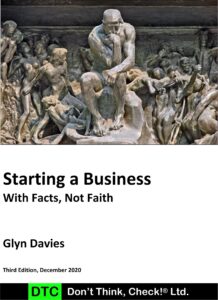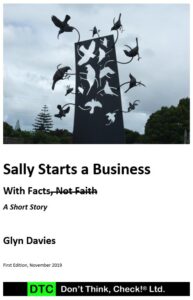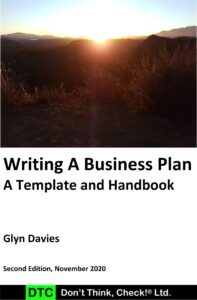

It is Cargo Cult Business Advice to recommend creating a Business Plan as the first thing or virtually the first thing you should do if you’re contemplating starting a business.
What follows is an example list of the first three recommendations of a typical ten-point starting a business list:
- Start by creating a SWOT analysis. Where SWOT is a mnemonic acronym for Strengths, Weaknesses, Opportunities, and Threats. I think they meant perform, not create, as the SWOT analysis framework has already been created. But perform an analysis of what, the business that doesn’t exist yet for which you are creating a Business Plan for in the first place?
- Understand what the key elements to include in your Business Plan, and then
- Create a High-level Business Plan.
Okay, since details matter, let’s accept that creating a Business Plan is practically, though strictly not the first thing that they recommend.
Nowhere do they suggest finding out if there is a market for your business idea, what I call a Solution, where a Solution is a bundle of products, services and experiences.
My gripe with the whole start with a Business Plan approach is that it is either making implicit the need for a Solution, or it is ignoring the need for a Solution completely. See the article I wrote called Business Plans – when are they needed? Another way to think of this is, see a need, fill a need.
If you’re interested, I also have a series of episodes outlining what is really involved in starting a business. And no, guiding you to my episodes and therefore eBook is not a shameless plug, as I provide ample references for you to join the dots all by yourself.
Anyhow, a person could spend a lot of time writing a Business Plan, only for the whole exercise to prove to have been futile from the outset.
A better approach is to perform some research on your business idea, assumptions, and beliefs, and you can simply start this with an internet search. You should also get out of the building, and depending on your business idea, go out and count the number of burger bars, cafes, laundromats, shoe shops, etc. Writing a Business Plan is not going to tell you that there are already ten cafes within walking distance of your proposed cafe location.
I met recently with a client, let’s call him Allan, who had downloaded the business.govt.nz Business Plan Template (a great document) and had done lots of work to fill it out for his entrepreneurial concept, a baby clothing Solution. Alan had dutifully followed Cargo Cult Business Advice.
Allan’s Solution concept was great, and a quick internet search confirmed that there was an established market for such a Solution. An existing market means that you don’t need to spend time and money on educating prospective customers. But the downside is that the internet search also revealed another nugget of information – the market is likely saturated with Solution options, with one of many many retailers having 150 Solution variations covering every price bracket.
What this meant for Allan was that since he did not have a Distinctive Value Proposition (DVP), he was unlikely to attract attention to his Solution in the ocean of competition, let alone sell any, and he didn’t need to fill out a Business Plan to figure this out.
Along with basic research such as talking to prospective target customers, walking the streets, and searching the internet, you can also perform a Break-even Analysis to determine the level of sales that will completely cover all your costs, and therefore the level of sales that will start returning a profit.
With the example of Allan above, how many units would he have to sell to cover all his costs? With information from Statistics New Zealand suggesting that in 2017 there were around 59,610 live births, how many of those babies does he need as customers? What if, as is extremely likely, he can’t get all 59,610 babies?
Performing a break-even analysis in the early days of a startup is not going to be accurate, as you may not have all the information you need. But accuracy is not the purpose of break-even analysis and is one of its criticisms. But it doesn’t need to be accurate. All we want to know, before investing too much time and money and creating Business Plans is, how many will you likely need to sell? What if Allan’s break-even analysis indicated that he needed to sell 100,000 or 60,000 or 40,000 or 10,000 units. Accepting that there are some shortcomings in break-even analysis and that Allan is very unlikely to capture the whole market, what do the results of the break-even analysis tell you about Allan’s probability of success?
In summary, there are a number of steps a person can take before they need to create a Business Plan. The ongoing default and reflexive advice to create a Business Plan as the first or the near first step is not only a dubious use of time, but it’s also bordering on pretentious false-authority. It’s getting people doing seemingly serious and important busy-work, instead of getting them out of the building and into the real world where the inconvenient facts lurk. This default advice demonstrates more of a cargo-cult[1] mentality than anything else, where cargo cult behaviour is the semblance of doing things right, regardless of the merits of the activity, the science and evidence, or the context. Advising prospective entrepreneurs to create a Business Plan as a first step is cargo cult advice, it’s not too far removed from reciting spells and incantations, and is just as effective.
#DontThinkCheck #BusinessResultant #StartMyBusiness #RunMyBusiness #SeeANeedFillANeed
[1] As a well-known example of cargo cult behaviour, Richard R. Feynman wrote “In the South Seas there is a cargo cult of people. During the war they saw airplanes land with lots of good materials, and they want the same thing to happen now. So they’ve arranged to make things like runways, to put fires along the sides of the runways, to make a wooden hut for a man to sit in, with two wooden pieces on his head like headphones and bars of bamboo sticking out like antennas he’s the controller and they wait for the airplanes to land. They’re doing everything right. The form is perfect. It looks exactly the way it looked before. But it doesn’t work. No airplanes land. So I call these things cargo cult science, because they follow all the apparent precepts and forms of scientific investigation, but they’re missing something essential, because the planes don’t land.”



